|
NOTES AND
EXTRACTS
ON THE HISTORY OF THE
LONDON & BIRMINGHAM RAILWAY
CHAPTER
1.
EARLY RAILWAYS
INTRODUCTION
|
“It is a common error to
suppose that there were neither railways nor locomotives
before the era of George Stephenson, Edward Pease, and
the Stockton and Darlington Railway. The fact is, that
mechanical locomotion, by the adhesion of the rim of a
loaded wheel to the surface upon which it rolled, while
being forced to revolve by some tangential force, is
very old . . . .”
A History of the
Stockton and Darlington Railway, J. S. Jeans (1875). |
. . . .
indeed, not only does the history
of the railway locomotive predate the Stockton and Darlington
Railway by some two decades, but the history of railways predates
that of railway locomotives by at least two centuries.
To some extent, the early development of
rail transport stemmed from the abysmal condition of British roads.
The Romans understood the need for good roads and how to build them,
at least to the standard that they required, but following their
departure from our shores road building and maintenance sank into
a state of oblivion from which it did not begin to emerge until the
18th Century. Even then, it was many years before a
system of trunk roads of a reasonable standard were built. Thus,
in the absence of good roads, the only practical means of
transporting deadweight cargoes such as coal, stone and minerals in any quantity was by water, and many of our early railways were built to link
mines and quarries to the nearest waterway.
Besides
the guidance that a line of rails imposes on a train of wagons,
rails also greatly reduce ‘friction’; in other words, the resistance encountered
when one body is moved when in contact with another. Much less
energy is required to move a wheeled vehicle over smooth and
hardened rails, than over the softer, more resistant surface of a
road. Whereas a horse could haul a wagon loaded to ⅝ ton over an
unmade road, or 2 tons if on a macadamised surface, the same horse could haul 8 tons on a railway and up to 50
tons on a canal. And so the question arises, why, when they arrived
in the 1840s, did the new locomotive-operated railways quickly
displace the canals?
――――♦――――
THE CANALS
Canals were our earliest man-made bulk
carriers, the Bridgewater Canal [1] being the first to
enter
service. Following its success, many more canals were built until
by their peak in the 1840s there was over 4,000 miles of inland
waterways.
During the early period of canal building,
speed on transit was relatively unimportant when balanced against a
canal’s capacity to move heavy loads over distance. But as the
Industrial Revolution progressed, time increasingly cost money and
the new locomotive-operated railways soon demonstrated that they
could move heavy loads reliably and at speed. Whereas three men
could move 50 tons in a pair of narrow boats at the pace of a
walking horse, the same manpower could shift 500 tons in a goods
train at ten times the speed.
 |
|
The leisurely pace of
canal traffic. |
And other factors acted against
canals:
• compared with a canal, railways were cheaper to build and more adaptable to the
terrain, for a canal needed a sufficient water supply that was
sometimes difficult and expensive to obtain;
•
crossing high ground required a system of locks, which were
expensive to build and maintain, slowed traffic, and often
required one or more pumping stations to lift water to their
summit level;
•
droughts in summer and ice in winter brought canals to a
standstill, often for long periods;
.JPG) |
|
Ice, an old enemy of the
canals. River barges frozen in on the Grand Union Canal
at Hanwell
during the winter of 1962-3. |
•
there were no mandated standards governing canal construction;
thus, interworking between different waterways was sometimes impossible
due to the incompatible sizes of the canal craft designed to operate
on them;
•
canal companies resisted the introduction of steam-powered
barges for many years due to their unwillingness to invest in
bank reinforcement for protecting against the erosion caused by
propeller turbulence;
•
the waterway network had no equivalent to the Railway Clearing
House for allocating tolls for traffic moving between different
companies’ systems, which could result in chaotic charging,
particularly for long distance
traffic; and
last but not least was . . . .
• the parochial and complacent attitude of
the canal companies. This prevented mergers that would have brought
longer waterway routes under unified control. From an early
date, mergers between railway companies resulted in longer
routes coming under a single management with accompanying gains
in technical standardisation, administrative efficiency and economies of scale.
And so
the new railway companies quickly captured most of the canal trade, leaving once
important canals to eke out a bare existence, or go to the wall ― and
many did.
――――♦――――
THE RAILWAY ERAS.
“It will be evident that such a work as
this could only have been undertaken in a country abounding with
capital, and possessing engineering talent of the highest order. The
steps, by which the science of Railways has arrived at its present
position, were slow yet progressive. Railways of wood and stone were
in use, as well as the flat iron or tramrail, in the middle of the
seventeenth century, particularly among the collieries of the north,
and were gradually improved from time to time; they still, however,
retained a character totally distinct from those structures which
will soon form the means of transport through the principal
districts of the Kingdom.”
The History of the Railway
Connecting London with Birmingham, Lieut. Peter Lecount RN
(1839).
For the purposes of this account, ‘early
railways’ were those that predate 1830 and the opening of the
Liverpool and Manchester Railway, the Stockton and Darlington
Railway (1825) lying on the transitional boundary.
Broadly speaking, railways fall into three
eras, although the transition between each was more a matter of
evolution than of sudden change, with some examples of early types
of railway surviving well past obsolescence, even into the 20th
Century.
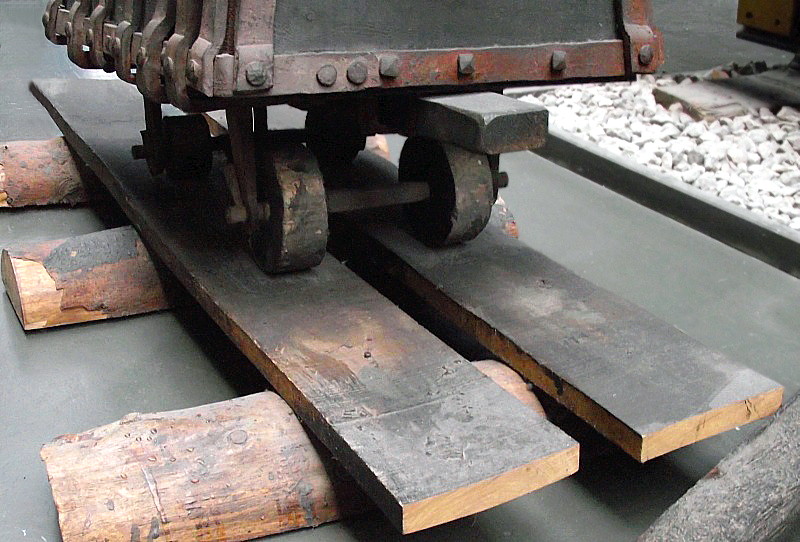
Wooden railway - a peg running
between the planks kept the truck in alignment.
National Railway Museum, York.
The earliest era was that of the ‘wooden
railway’, so named because of its timber construction. Wooden trucks
were pushed along wooden planks using a peg running within a slot to
keep the wagon wheels aligned with the planks. By the beginning of
the Industrial Revolution, the planks had become wooden rails, the
wagons were larger and horse-drawn and their wheel were by then
acquiring iron tyres, later becoming all iron (ca. 1730). Towards the end of this era, the life of wooden rails was being
extended with the use of cast iron reinforcing strips (ca.
1770), and so there began a gradual transition into the intermediate
era, that of the ‘iron railway’ (ca. 1790), during which
all-iron rails gradually replaced the earlier timber and composite
construction, and the first steam locomotives made their
tentative appearance.
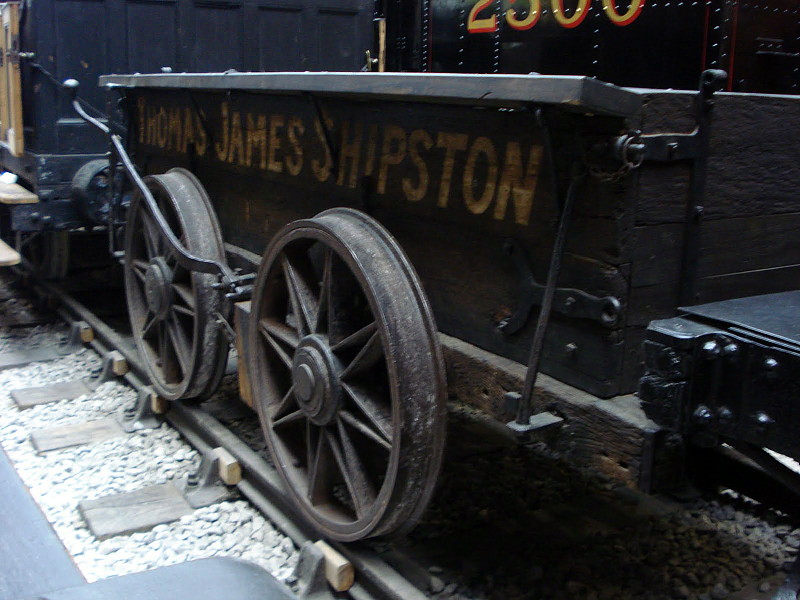
Moving on to the 1820s, this wagon
from the Stratford and Moreton Tramway
has iron flanged wheels
designed to run oniron edge rails, but note the absence
of suspension and shock-absorbers (buffers).
National Railway
Museum, York.
In its
turn the iron railway reached its zenith in the Stockton and
Darlington Railway, from where railway engineering (together with
railway administration) progressed to the Liverpool and Manchester
Railway, which marked the beginning of the era of the modern public railway. From then on entrepreneurs entered the
field, creating railway companies that eventually grew to form a
national network operated solely for the purpose of creating
wealth for its constituent companies’ shareholders.
――――♦――――
TERMINOLOGY.
In common usage, we refer today to metal
tracks designed to carry wheeled vehicles as ‘railways’ or
‘tramways’, although at the lightweight end of what is quite a broad
spectrum of descriptions there exists some distinction (both between
and within) ‘underground’, ’rapid transit’, ‘light rail’ and
‘tramways’.
|
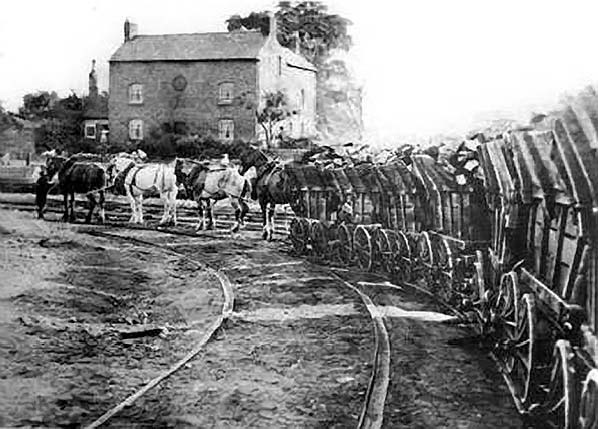 |
|
The Little Eaton Gangway,
Derbyshire (1795-1908).
Note the L-section plate rails,
typical of many early railways. |
The terminology used to describe early
railways is more confusing. It was subject to regional variations,
to the type of engineering employed, and how the owners wished to
describe their line. Thus, the terms ‘wagonway’, ‘plateway’,
‘tramway’, ‘dramway’, ‘gangway’ and even ‘railway’ (or ‘rail-road’)
crop up, to name but some. Sometimes the name implies the type of
engineering employed, but not always ― strictly speaking, the
‘Surrey Iron Railway’ (described later) was a ‘plateway’, a term
that applies to horse-operated lines that utilised cast iron single
or double L-shaped plates on which ran wagons fitted with rimless (unflanged)
wheels. The term ‘railway’ came to describe lines constructed with
iron ‘edge rails’ that supported vehicles fitted with flanged
wheels, the predecessor of the modern railway.
However they were named, early
railways in general:
• were short lines, built mainly to transport
their owners’ goods, often to a waterway wharf;
• used horse-drawn wagons (steam traction began to
make its appearance towards the end of the era);
• were engineered with embankments and cuttings to
level the terrain, and bridges to cross waterways, but often
incorporated steep, rope-worked ‘inclines’ that were avoided by
later railway engineers;
• usually consisted of a single track with passing
places;
• used rails of various designs and materials
(wood, wood/cast iron composite, cast iron and later malleable iron
[2]), set to various gauges and mounted on
transverse wooden sleepers, or on blocks of either wood or stone and
sometimes a mixture (as in the case of the Stockton and Darlington
Railway);
• provided a gravelled surface between the rails
suitable for horses to walk on, or if transverse sleepers were used,
they were sunk into the ballast to avoid being damaged by horses’
hooves.
The ‘early railway’
era ended with the opening of the Liverpool
and Manchester Railway in 1830. From then on railways began to be built as
businesses in themselves, the aim being to make profits for their investors. They
offered the public a service carrying not only goods, but passengers;
they used locomotive-hauled trains; they operated to a timetable accompanied by a schedule of fares and charges; and,
increasingly, they linked towns and cities throughout the land.
These are all
features that we would recognise in our railway network today.
――――♦――――
WAGONWAYS.
Although ‘wagonways’ ― to use a general
description ― undoubtedly existed in Britain before the 17th
Century, the earliest to be recorded was built ca. 1603 to
convey coal from the mines at Strelley to the west Nottingham, to Wollaton, a distance of some two miles. [3] Its builder, colliery
owner Huntingdon Beaumont, later constructed other wagonways to
serve his mining interests near Blyth in Northumberland:
“Among the rest of the ‘rare engines’ introduced by
master Beaumont into the coal trade, one was ‘Waggons with one horse
to carry down coales from the pits to the staiths to the river.’ Lord Keeper Guilford, in 1676, thus describes them: ‘The manner of
the carriage is by laying rails of timber from the colliery down to
the river, exactly straight and parallel; and bulky carts are made
with four rowlers, fitting these rails, whereby the carriage is so
easy, that one horse will draw down four or five chaldron of coals,
and is an immense benefit to the coal merchants.’”
An Historical, Topographical, and Descriptive View of
the County of Northumberland,
Eneas Mackenzie (1825).
From here began the evolution of the
wagonway in the north-east of England, where many local systems grew
up to serve the collieries around the Tees, Tyne and Wear. It is
with some justification that this locality can be described as the
‘birthplace of the railway’. [4] These
wagonways were laid across land between colliery and waterway by
private arrangement with the owners, the proprietor of the wagonway
paying an annual rent under the name of ‘wayleave’. Where a public road had to be crossed,
this was by consent of the local authority. But as wagonways
developed, it was not always found practicable to arrange such
informal rights of passage, particularly when a line of considerable
length had to be laid down, and an Act of
Parliament became a necessary expedient. Such private legislation was used
to obtain the necessary powers to cross public
highways and to purchase ― by compulsion, but with fair compensation ― private land on which to lay the track.
The first application to Parliament for a ‘Railway Act’ was made in
1801, to authorise construction of the Surrey
Iron Railway. By then compulsory purchase was
already established in Acts authorising the construction of
canals. [5]
Besides being the first Act
of Parliament to contain the work ‘Railway’ ― it was in fact a
wagonway ― the Surrey Iron Railway was the first line intended for
public use. In the following 20 years, more such lines were
built (listed in the Appendix). But despite their importance to particular
businesses and localities, in themselves wagonways were
unimportant. Short and widely dispersed, they did not become part of the
railway network that eventually extended throughout the
land. Their importance lay in providing a testing ground for the
early development of railway engineering, both civil and mechanical, in particular the
development of the malleable iron edge rail and the steam
locomotive.
Despite their misleading titles, the following are
examples of some notable wagonways.
――――♦――――
BRANDLING’S RAILROAD
(the Middleton Railway).
Opened in 1758, this wagonway
was built by Charles Brandling to
link his collieries at Middleton with Leeds. It is
credited with being the world’s oldest continuously working line, a
short section ― a standard gauge railway since 1881 ― remaining in
use as a heritage site.
Brandling needed to transport his coal to
market in Leeds, but did not have access to a waterway for that
purpose. His agent, Richard Humble, solved the problem with wooden
wagonways, which were common in his native north east. The first,
constructed in 1755, crossed Brandling’s land and that of friendly
neighbours to riverside staithes, but two years later he began work
on a wagonway into Leeds itself. The line was financed privately and
operated using horse-drawn vehicles called ‘corves’.

Wishing to protect his investment with a
degree of permanence, Brandling obtained a private Act of
Parliament, the first piece legislation to refer to a wagonway.
Unlike later canal and railway Acts, it did not give powers of
compulsory purchase, but instead ratified existing wayleaves. In
return, the Act required Brandling to send into Leeds 240,000 corves
(a corf was defined as 210lbs., giving 22,500 tons) of coal a year
for 60 years, for which he was to receive 4¾d a corf, or 6d a corf
for delivery to specific dwellings. For the cheaper rate, all coal
had to be off-loaded at Cassons Close, and on no account was a coal
merchant to be employed; the purchaser had to make his own
arrangements. [6]
“On Wednesday last the first waggon Load of Coals was
brought from the Pits of Charles Brandling, Esq., down the new Road
to his Staith near the Bridge in this Town, agreeable to the Act of
Parliament passed last Sessions. ― A Scheme of such general Utility,
as to comprehend within it, not only our Trade and Poor, (which
ought to be grand objects of our Concern) but also beneficial to
every Individual within this Town and Neighbourhood: On this
Occasion the Bells were set a ringing, the Cannons of our FORT
fired, and a general Joy appear’d in every Face.”
Leeds
Intelligencer,
26th September 1758.
Around 1807 the wooden tracks began to be
replaced with iron rails to a gauge of 4 feet 1inch.
|
On Wednesday last a highly
interesting experiment was made with a Machine,
constructed by Messrs. FENTON, MURRAY
and WOOD, of this place, under the
direction of Mr. BLENKINSOP, the
Patentee, for the purpose of substituting the agency of
steam for the use of horses in the conveyance of coals
on the Iron-rail-way from the mines of J. C. Brandling,
Esq. at Middleton, to Leeds. This machinery is, in fact,
a steam-engine of four horses’
power, which, with the assistance of cranks turning a
cog-wheel, and iron cogs placed on one side of the
rail-way, is capable of moving, when lightly loaded, at
the speed of ten miles an hour. At four o’clock
in the afternoon, the machine ran from the coal-staith
to the top of Hunslet Moor, where six, and afterwards
eight waggons of coals, each weighing 3¼ tons, were
hooked to the back part. With this immense weight, to
which, as it approached the town, was super-added about
50 of the spectators mounted upon the waggons, it set
off on its return journey to the Coal-staith, and
performed the journey, a distance of about a mile and a
half, principally on a dead level, in 23 minutes,
without the slightest accident. The experiment, which
was witnessed by thousands of spectators, was crowned
with complete success; and when it is considered that
this invention is applicable to all rail-roads, and upon
the works of Mr. Brandling alone, the use of 50 horses
will be dispensed with, and the corn necessary for the
consumption of, at least, 200 men saved, we cannot
forbear to hail the invention as of vast public utility,
and to rank the inventor among the benefactors of his
country.
The Leeds
Mercury, 27th June 1812. |
Following its opening in September, 1758, Brandling’s wagonway conveyed
thousands of tons of coal into Leeds each year. Cheaper coal, based
on more efficient transport, gave Leeds a head start in the newly
developing large-scale industries and the City was to grow into an
important centre for heat-dependant processes, such as metal-working
and brewing; the manufacture of bricks, glass, pottery and tiles;
and cloth-making in steam-powered mills. But the Middleton Railway
was to make its mark in history for another more significant
reason. In 1812 it became the site of the world’s first rack
railway (an idea later exploited on mountain railways, such as that
on Snowden) and of the first commercially viable steam locomotive
(see Chapter 2). Priestly later described it thus:
“BRANDLING’S RAILROAD
31 George II. Cap 22 Royal Assent 9th June 1758.
This railroad proceeds from the extensive collieries,
situate at Middleton, (belonging to the Rev. R.H. Brandling) about
three miles south of the town of Leeds, and terminates at convenient
staiths, near Meadow Lane in the above town. It is three miles in
length, and was constructed under the powers of an act, entitled, ‘An
Act for establishing Agreements made between Charles Brandling, Esq.
and other Persons, Proprietors of Lands, for laying down a Waggon
Way, in order for the better supplying the town and neighbourhood of
Leeds, in the county of York, with Coals.’
There are upon this railway two inclined planes, one
at the southern corner of Hunslet Carr, and the other at Belleisle,
near Middleton, upon which the full descending waggons, regulated by
a brake, draw up the empty ones. It is here worthy of remark, that
it was upon this railway that the powers of the locomotive engine
were first applied in this part of the country, by the ingenious
inventor, Mr. John Blenkinsop, the manager of the Middleton
Collieries.”
Historical Account of the Navigable Rivers, Canals,
and Railways,
Joseph Priestley (1831).
Having
seen Blenkinsop’s locomotive at work on
the Middleton wagonway and recognising its potential, George
Stephenson set to work at the Killingworth and Hetton collieries the chain of development that
would eventually lead to the
mainline steam locomotive. In the process he gained valuable experience in
railway construction that he would later apply to the Stockton and Darlington,
the Liverpool and Manchester, and other lines.
――――♦――――
THE SURRY
IRON RAILWAY.
Opened in 1803, the Surrey Iron Railway (SIR)
was a purely commercial venture. In common with many
other wagonways (which is what it was), its purpose was to improve
access to a waterway, in this case to link the industrial areas
extending from Croydon along the Wandle Valley to Wandsworth on the
Thames. However, the SIR was not intended for private use; its enabling
Act was framed in a similar manner to that for a canal, authorising
the Company to provide a track on which the public could convey
their goods for payment of the appropriate toll, but it was left to
the user to arrange conveyance in their own wagons or in those of a
haulage contractor. [7] The SIR was therefore our first public
railway:
“The Surrey Iron Railway promises to be one of the
most useful public works that have late been undertaken for the
improvement of the country. These iron roads are excellent
substitutes for canals, and in some instances superior to them. They
are executed at one third of the expense; and by not obstructing the
natural flow of rivers, all the evils with which the canals are at
times accompanies, are avoided. One horse on an iron railway will do
the work of ten, and the speed with which carriage is performed
exceeds all other modes of conveyance. This iron railway commencing
at Wandsworth, will in all probability be extended to Portsmouth, by
which at all times of the year, and in the severest storms, when
canals are blocked up by ice, stores might be in one day conveyed
from Woolwich Warren to our fleets at Spithead ― a thing which it
has been long in contemplation to effect.”
The Reading Mercury,
1st June 1801.
The original plan had been to link Croydon
and Wandsworth by canal. The civil engineer William Jessop reviewed
the route and while declaring a canal to be feasible he felt it
impractical due to the sole source of water, the River Wandle, being
heavily used by water-driven factories and mills. Instead, he
proposed linking the towns by wagonway along a route running south from
the Thames at Wandsworth, through Streatham, Tooting, Wimbledon, Merton, Mitcham and Beddington to Croydon, where it terminated at Pitlake
Meadow.
Having visited some
existing wagonways, the proprietors decided in favour of Jessop’s
scheme and engaged him to engineer the 9¼-mile line. Jessop’s estimate for the work was
£33,000, which included a substantial basin at Wandsworth capable of
holding 30 barges, and an entrance lock into the Thames. In February 1801 a Bill was laid before Parliament, and later that year the
proprietors of the Surrey Iron Railway
became the first company to obtain an Act with ‘Railway’ in its
title:
[8]
“An
Act for making and maintaining a Railway from the town of Wandsworth
to the town of Croydon, with a collateral Branch into the parish of
Carshalton, and a navigable Communication between the River Thames
and the said Railway at Wandsworth, all in the county of Surrey.”
41 George III. Cap. 33, Royal Assent 21st May, 1801.
In his Historical Account of the Navigable Rivers, Canals, and
Railways of Great Britain (1831), Joseph Priestly provides
information on what the Act contained regarding the raising of
capital and charging of tolls:
“It incorporates the subscribers by the name of ‘The
Surrey Iron Railway Company’ and empowers them to raise, for the
purposes of the undertaking, amongst themselves the sum of £35,000,
in three hundred and fifty shares of £100 each, and, if necessary, a
further sum of £15,000, either amongst themselves, by creation of
new shares or by mortgage of the tolls and rates, and also
authorizes them to take the following:
TONNAGE RATES
For all Goods Wares and Merchandize
whatever carried into or out of the Dock or Basin . . . . 4d per
Ton;
For all Dung carried on the Railway . . . . 2d per Ton, per Mile;
For all Lime stone, Chalk Lime and all other Manure, except (Dung)
Clay, Breeze, Ashes, Sand and Bricks . . . . 3d per Ton, per Mile;
For all Tin, Copper, Lead, Iron stone, Flints, Coal, Charcoal, Coke,
Culm, Fullers Earth, Corn and Seeds, Flour, Malt, and Potatoes . . .
. 4d per Ton, per Mile;
For all other Goods, Wares and Merchandize . . . . 6d per Ton, per
Mile;
Fractions of a Quarter of a Ton to be considered as a Quarter, but
all Fraction of a Mile as a Mile.”
Any person was at liberty to put wagons on the line and to
carry goods within the prescribed rates. The Company was also given
compulsory powers to lease wayleaves across land, and in the event
of differences arising as to price, &c., local commissioners named
in the Act were appointed to meet and determine disputes.
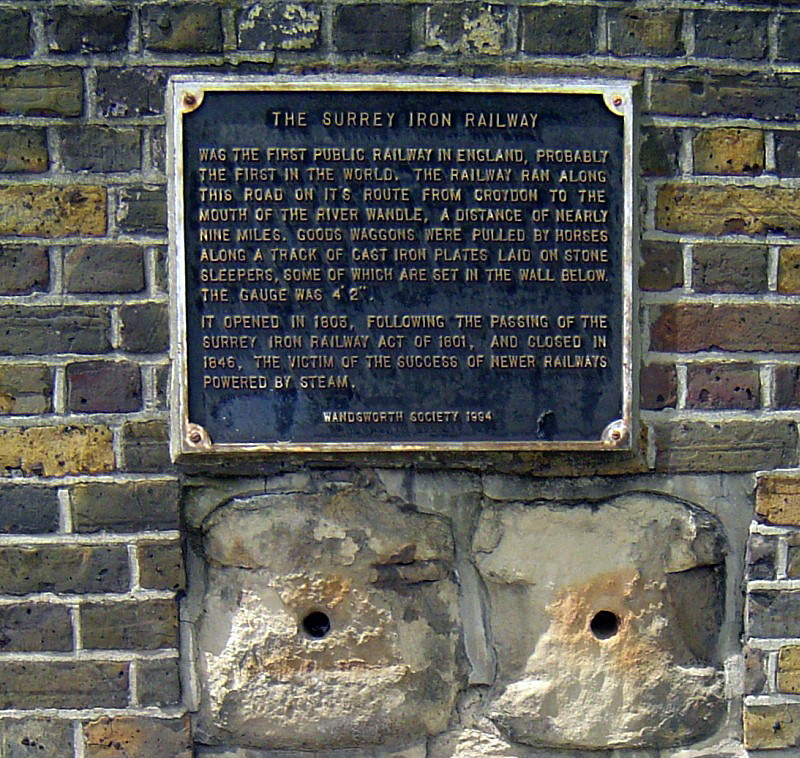
Below the memorial plaque are two
stone-block sleepers from the line.
Such sleepers were in
common use on early railways because they created a clear path
between the lines for horses to walk on, without the risk of
tripping.
Tenders
were invited to build the line, Benjamin Outram and Company [9]
winning the contract at £33,000. Construction progressed quickly,
the contractors being George Leather (father and son) with Outram
supervising the works:
“On Thursday last the lock, canal, and basin, from
which the proposed iron railway is to commence at Wandsworth, was
opened, and the water admitted from the Thames. The first barge
entered the lock, amidst a concourse of spectators, who rejoiced in
the completion of this part of the important and useful work. The
ground is laid for the railway, with some few intervals, all the way
to Croydon, and the undertakers wait only the approach of open
weather to lay down the iron.”
Jackson’s
Oxford Journal,
16th January 1802.
As built, the line was a double track
‘plateway’, the rails being cast iron L-shaped plates mounted on
stone blocks, an arrangement that left space between the tracks for
the horses’ hooves. The wagons had rimless wheels set to a gauge was
4 feet 2 inches and were initially hauled by horses, mules and
donkeys, but donkeys were found to be cheaper and later took over.
The line opened to the public in 1803, to
be followed by the 1¼ mile Carshalton Branch a year later:
“On Tuesday last the Iron railway from Wandsworth to
Crydon was opened to the public for the conveyance of goods. The
Committee went up in waggons drawn by one horse; and to show how
motion is facilitated by this ingenious and yet simple contrivance,
a gentleman, with two companions, drove up the railway, in a machine
of his own invention, without horses, at the rate of 15 miles per
hour. The Committee afterwards dined together at the King’s Arms, in
Croydon, and spent the day with the utmost conviviality.”
The Hampshire Telegraph, 8th August 1803.
In 1805 the Company returned to Parliament
for:
“An Act to enable the Company of Proprietors of the
Surrey Iron Railway to raise a further Sum of Money, for completing
the said Railway, and the Works thereunto belonging.”
45 George III. Cap. 5, Royal Assent 12th March 1805.
. . . . which authorised the Company to
raise a further £10,000, some of which paid for enlarging the
Wandsworth basin. The final cost of the project overall was £60,000, almost
twice the original estimate.
Enthusiasm for the SIR led to the Croydon,
Merstham and Godstone Railway being formed to extend the line to
Reigate, there to exploit the stone and chalk of the area, with the possibility of eventually
reaching Portsmouth:
“An Act for making and maintaining a Railway from, or
from near, a place called Pitlake Meadow, in the town of Croydon,
to, or near to, the town of Reigate, in the county of Surrey, with a
collateral Branch from the said Railway, at or near a place called
Merstham, in the parish of Merstham, to, or near to, a place called
Godstone Green, in the parish of Godstone, all in the said county of
Surrey.”
43 Geo III Cap. 35, Royal Assent 17th May 1803.
But the project was seriously
under-capitalised and despite an application to Parliament for:
“An Act for better enabling the Company of Proprietors
of the Croydon, Merstham and Godstone Iron Railway, to complete the
same.”
46 Geo III. Cap. 93, Royal Assent 3rd July 1806.
. . . . the line only reached Merstham,
which, together with its branches, added a further 16 miles to the
SIR. Jessop was the engineer and Outram’s company was both
civil engineering contractor and supplier of the iron rails. [10]
Neither railway prospered. The Croydon to Merstham line closed in 1838, its trackbed being acquired by the
London and Brighton Railway. It was followed in 1846 by the SIR, its trackbed being sold to local landowners and to the
Wimbledon and Croydon Railway Company. Both
lines were abandoned by Act of Parliament.
Following the opening of
the Merstham line, an interesting article appeared in a number of
newspapers that gives some insight into a wagonway’s carrying
capacity:
“The SURREY IRON RAILWAY being completed, and opened
for the carriage of goods all the way from Wandsworth to Merstham, a
bet was made between two Gentlemen, that a common horse could draw
thirty-six tons for six miles along the road, and that he could draw
this weight from a dead pull, as well as turn it round the
occasional windings of the road. Wednesday last was fixed for the
trial; and a number of Gentlemen assembled near Merstham to see this
extraordinary triumph of art. Twelve waggons loaded with stones,
each waggon weighing above three tons, were chained together, and a horse taken from the timber cart of Mr. Harwood, was
yoked into the team. He started from near the Fox Public-house, and
drew the immense train of waggons with apparent ease to near the
Turnpike at Croydon, a distance of six miles, in one hour and 41
minutes, which is nearly at the rate of four miles an hour. In the
course of this time he stopped four times, to shew that is was not
be the impetus of the descent that the power was acquired ― after
each stoppage he draw off the chain of waggons from a dead rest.
Having gained his wager, Mr. Banks, the gentleman who
laid the bet, directed four more loaded waggons to be added to the
cavalcade, with which the same horse again set off with undiminished
power; and still further to shew the effect of the railway in
facilitating motion, he directed the attending workmen, to the
number of about fifty, to mount on the waggons, and the horse
proceeded without the least distress, and in truth, there appeared
to be scarcely any limitation to the power of his draught. After the
trial the waggons were taken to the weighing machine, and it
appeared that the whole weight was . . . .
[55 tons 6 cwts 2 qtrs].”
The
Morning Post,
5th July 1805.
――――♦――――
THE
STOCKTON AND DARLINGTON RAILWAY.
|
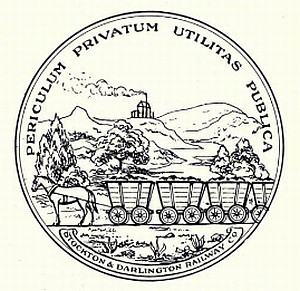 |
|
The Company emblem is
indicative that the Railway was only
partly worked by
steam locomotives
in its early days. |
The transition between the era of the
‘iron railway’ and that of the ‘modern railway’ ― or at least a
railway that, in its essentials, would be recognisable as such
today ― was by no means immediate. The
transitional period began in 1825 with the
opening of the Stockton and Darlington Railway and extended to at least
the opening of the Grand Junction and the London and Birmingham lines in 1837 and 1838. Neither was its arrival solely a matter of new
technology, as had largely been the case with earlier
transitions, for with the modern railway came the beginning of railway
administration, of the active marketing of railway services, and
of interworking
between the networks of different railway companies, and all on a grand scale.
The Stockton and Darlington Railway is
sometimes considered to be the beginning of the modern railway era,
but although it incorporated much that had been learned in the
fields of mechanical and civil engineering (mainly in locomotive and
track design), initially it retained many of the features
of the colliery wagonway.
The line was first surveyed [11] by George Overton, a Welsh canal and railway engineer now remembered
mostly for his work in connection with the Pen-y-Darren wagonway, the
site of Richard Trevithick’s steam locomotive experiment of 1804
(Chapter 2). Using Overton’s survey, the proprietors applied to
Parliament for a railway Act in 1819, but their application was
rejected due to the opposition of landowners, Lord Darlington in
particular. Their second application was based on an altered route.
It met
with little opposition, and in 1821 the Stockton and Darlington Railway
Company obtained:
“An Act for making and maintaining a railway or
tramroad from the River Tees at Stockton to Witton Park Colliery
with several branches therefrom, all in the County of Durham.”
l & 2 Geo. IV. C. 44, R.A. 19th April, 1821.
However, Edward Pease, an influential director
of the Company, was unimpressed with Overton and his proposed
route. Influenced by George Stephenson’s
growing reputation, Pease invited him to Darlington where Stephenson arrived on 19th
April 1821 in company with
Nicholas Wood, that being the day on which the Stockton and Darlington Railway Act
received the Royal Assent. At the time, Stephenson was employed constructing a
7-mile wagonway between Hetton Colliery and staithes on the
River Wear.
|
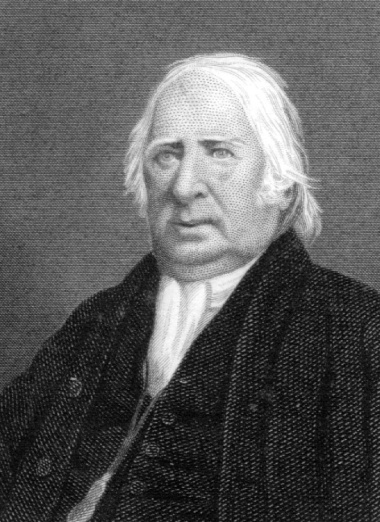 |
|
Edward Pease (1767-1858),
Quaker, anti-slavery campaigner
and railway
pioneer ―
“a man of weight, of prudence,
of keen commercial
instincts”. |
The directors’ original intention had been
to work the line with horses, but in the conversation between them
Stephenson suggested that it should be worked entirely by steam.
Pease subsequently visited Killingworth to see the colliery
locomotives at work and was impressed with what he saw. The outcome was
that Stephenson was engaged by the Company to re-survey Overton’s
route. This he shortened by three miles and eased the gradients,
although two substantial ‘inclined planes’ remained. [12] Following
the survey, Stephenson was appointed Engineer to the Company.
Taken together, the changes that
Stephenson proposed ― to which were added the conveyance of
passengers and parcels, both a novelty ― required a further Act of
Parliament, which the Company obtained in 1823 (4 Geo. IV. C. 33,
R.A. 23rd May, 1823). Construction then went ahead, and the Stockton
and Darlington Railway was formally opened on 27th September
1825 to become the world’s first public railway to utilise
steam power. That said, the line was not worked
solely by steam, but also employed horse traction:
“. . . . its promoters had only anticipated the
carriage of 10,000 tons per annum, they had not thought of
passengers, and the locomotive appeared incapable of acquiring
the regularity required by such traffic. They began their work,
therefore, with animal power. Prior to the formation of this
railroad, there had been a coach traffic of fourteen or fifteen
persons weekly: the rail increased it to five or six hundred. Each
carriage was drawn by one horse, bearing, in ordinary cases, six
passengers inside, and from fifteen to twenty outside; ‘In fact,’
says one writer, ‘they do not seem to be at all particular, for in
cases of urgency they are seen crowding the coach on the top, sides,
or in any other part where they can get a footing: and they are
frequently so numerous, that when they descend from the coach and
begin to separate, it looks like the dismissal of a small
congregation.’ The general speed with one horse was ten miles an
hour.”
A History of the English Railway,
John Francis (1851).
In addition to locomotive and horse
traction, there were two steep rope-worked inclines, both powered by a
combination of stationary steam engines and gravity. This
system appears to have been influenced by Stephenson’s
construction of the Hetton Colliery wagonway:
“On the 18th of November, 1822, the Hetton Colliery
Railway, which had been formed under the direction of George
Stephenson, was brought into use, the traffic being worked over five
self-acting inclines and conveyed over other portions of the line by
locomotive and stationary engines. The directors of the Stockton and
Darlington Railway had thus an opportunity of seeing in another part
of the country a successful application of the principles which had
guided George Stephenson in the laying out of their own line.
These principles, deduced from a series of experiments
which he had made in conjunction with Nicholas Wood, were, as stated
by the latter:― (1) On the level or nearly level gradients, horses
or locomotive engines were proposed to be used, a rule being laid
down that, if practicable, the gradients ascending with the load
should not be more than 1 in 300; (2) in gradients descending with
the load, when more than 1 in 30, the use of self-acting planes; and
(3) in ascending gradients with the load, where the gradients did
not admit of the use of horses or locomotive engines, then fixed engines with ropes.”
The North Eastern Railway; its rise and development,
W. W. Tomlinson (1915).
For about five miles at the western end of
the Stockton and Darlington, stationary steam engines were used to
haul trains up the inclined planes at Brusselton and Etherley;
having reached the respective summits, the loaded wagons then descended
by gravity, hauling empty wagons up the incline in the process.
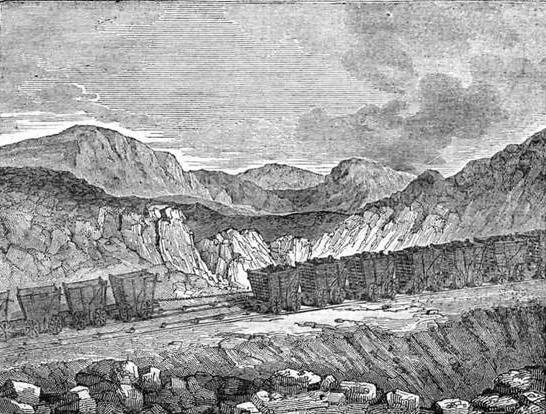 |
|
Inclined plane ― loaded
coal wagons descending
hauling empties up the slope.
|
Horses were then used to haul the wagons between the two inclines. For the remaining 20 miles or so eastwards from Shildon, the line
was at first worked by horses and by locomotives, although in
service the latter proved to be highly unreliable:
“On the 27th of September, 1825, the Stockton and
Darlington line of railway, twenty five miles long, was opened for
public traffic. Twenty miles of this was worked by locomotives and
horses, the powers of each being put thus in close competition. At
this early period of the history of a line of railway, the first
ever laid down on the improved principles as introduced by
Stephenson, and which formed the nucleus of the railway system, the
locomotives employed on it were five in number, four having been
manufactured by Messrs. Stephenson at their factory at Newcastle,
and one by Mr. Wilson of the same town. Such, however, was their
inefficient working condition, that the power of steam was about to
be abandoned and the railway conducted by horses.”
The Steam-Engine, its History and Mechanism,
Robert Scott Burn (1854).
The locomotives that Stephenson built for
the line were equipped with single-flue boilers, which, together
with the lack of an effective blast-pipe, resulted in their
inability to raise
sufficient steam to sustain the effort required to haul their loads. It was not until
Timothy Hackworth took over as locomotive superintendent that steam
traction on the line came to prove itself; nevertheless, horse
traction was not replaced entirely until 1833.
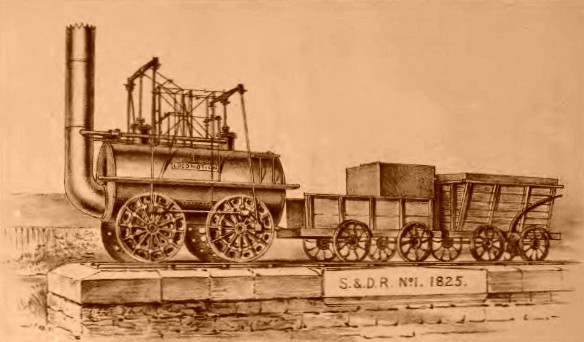
Stephenson’s
Locomotion No. 1, the first locomotive to run on a public railway.
Although authorised in its Act to carry
passengers, the line was built essentially to convey local coal to
the Tees for shipment further afield:
“In making thy survey, it must be borne in mind that
this is for a great public way, and to remain as long as any coal
in the district remains.”
Letter, Pease to Stephenson, 28th July 1821 [13].
Initially, the Railway was operated as a single track toll road; as
with the Surrey Iron Railway, the Company did not operate the
trains. Thus, for payment of the appropriate toll (laid down in the
Act), both steam and horse-hauled traffic could use the line
whenever they wished ― and in an uncontrolled manner that often
resulted in conflict. Only in later years did the Stockton and
Darlington acquire the characteristics of a modern public railway.
Nevertheless, it was a landmark in the use of steam-worked trains on
a public railway, and much was learned from its construction
and operation that was later applied elsewhere.
――――♦――――
THE
CANTERBURY AND WHITSTABLE RAILWAY.
from
The Railways of Great Britain and Ireland
by Francis Whishaw C.E.
London, 1840
The Canterbury and Whitstable was
the first railway in the south of England worked by stationary and
locomotive engines. It was projected by Mr William James, who
also originally proposed the Liverpool and Manchester Railway; but
who like many others spending his time and means for the public
good, died a poor and neglected man. [14]
The first Act of Parliament for the construction of this railway was
passed in 1825, being the 6th of Geo IV chap cxx. Three
additional acts have subsequently been obtained; the first received
the royal assent on the 2d April, 1827, by which the Company were
empowered to raise an additional capital in joint stock of £19,000.
By the second, which received the royal assent on the 9th May 1828,
£21,000 additional; and by the third, dated 21st July, 1835, a
further sum by loan of £40,000.
It [the Railway] was opened to the public on the 3d May,
1830; and although it is of great use to the citizens of Canterbury,
and the district generally through which it passes, it is far from
having answered the proprietors expectations.
When we visited this line in 1831, it was partly worked by fixed
engines, partly by one locomotive engine, [Invicta] and
partly by horses; but in 1839 we found that the locomotive engine
had been dispensed with. [Note]
The course of this line is nearly direct between the station at
Canterbury and the harbour at Whitstable. It is divided into
five planes; the first of which rises from Canterbury for 3,300
yards at the rate of 1 in 46, to the engine station at Tyler’s
Hill. The next plane is also on an ascent, rising at the rate
of 1 in 750 for 1,980 yards to the second engine station at Clow’s
Wood, which is the summit of the line. The line thence
descends for a length of 1,760 yards at the rate of 1 in 31.
For the next 2,200 yards the line is nearly level. Of the two
remaining planes to Whitstable, the first descends at the rate of 1
in 53 for 880 yards; and the second is nearly level being 440 yards
in length. Thus the whole length is six miles.
The principal traffic is in coals, which are brought coastwise to
Whitstable and thence by the railway to Canterbury. Passengers
are also conveyed at a moderate rate of charge; but the receipts on
this account are not considerable.
The fixed engines at Tyler’s
Hill and Clow’s
Wood are two of 25-horse and one of 15-horse power each,
respectively. The ropes used are of 3¼ inches circumference.
The sheeves are of 10 inches diameter, and 8 yards apart.
The way is single throughout; the gauge is 4 feet 8½ inches, and
each side-space 2 feet 7¾ inches wide; the top width of embankments
being 10 feet. The rails are of wrought iron, of light weight,
and are set in chairs with 3 feet bearings; the chairs being spiked
down to cross sleepers of oak.
The line is at present on lease to Messrs Nicholson and Bayliss
Editor's note.
Invicta was built at Newcastle by Robert Stephenson and
Company in 1830, and was the next locomotive built by that eminent
firm after the famous Rocket. The Invicta ran
upon only about a mile of level line of the 6-mile long Canterbury
and Whitstable Railway, the rest of which was worked partly by
horses and partly by ropes worked by stationary steam engines.
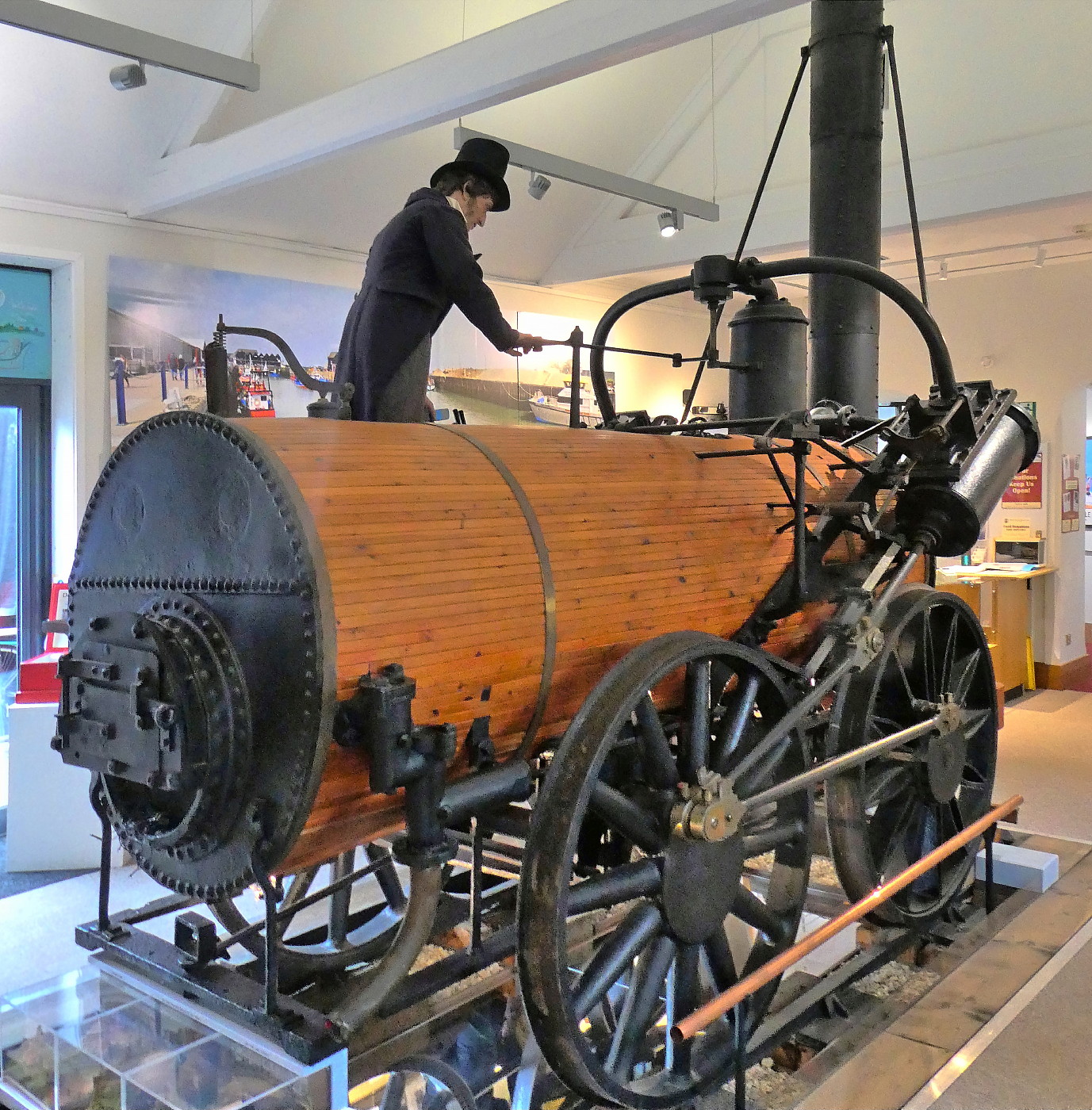 |
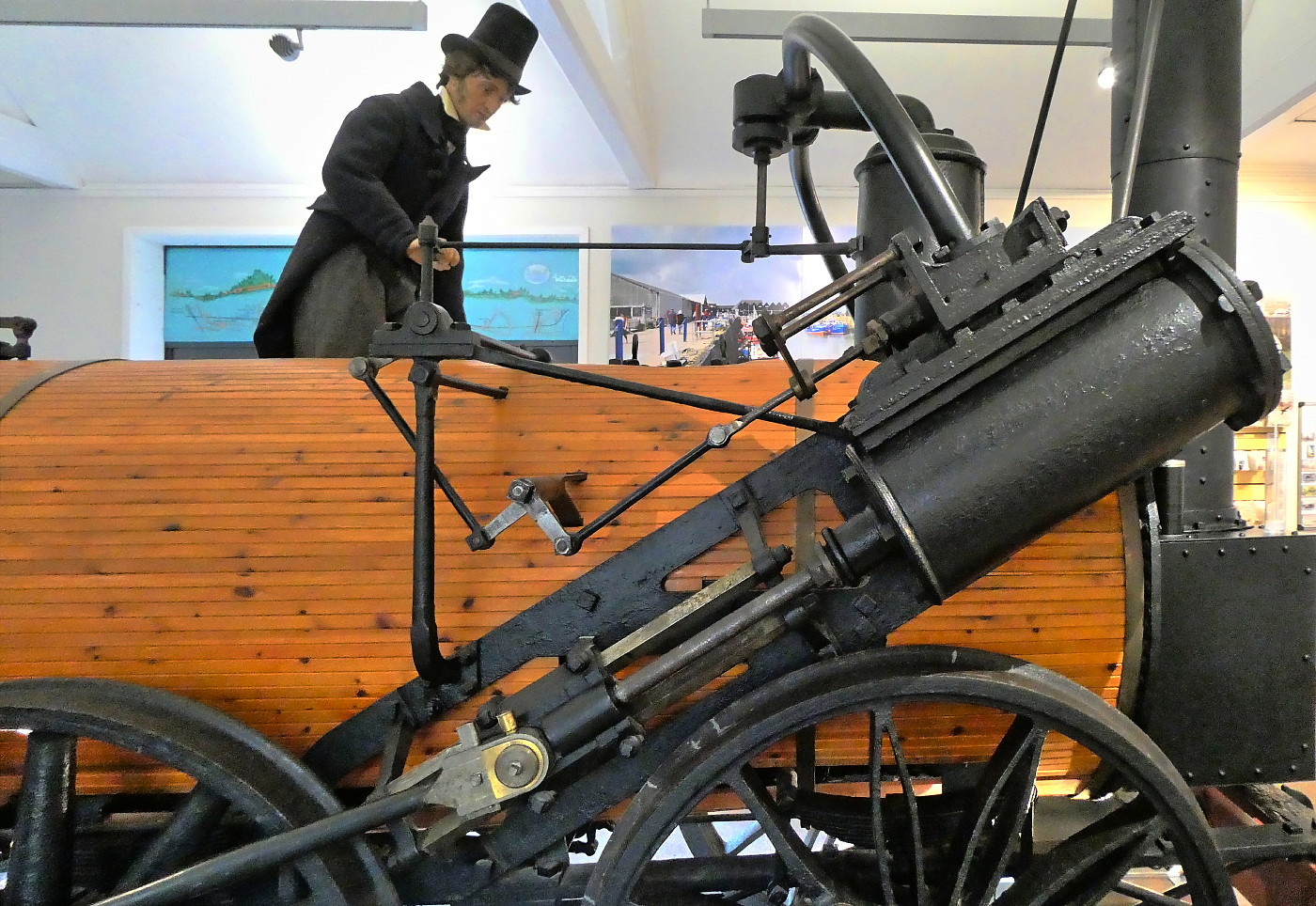 |
| Invicta, as rebuilt with
single flue boiler, on display at Whitstable Community
Museum & Gallery. |
The major controls, including the regulator, are located about
halfway along the boiler’s
left-hand side. It was operated by a driver, who stood on a
timber footboard mounted above the locomotive’s
rear wheel (as on Locomotion No. 1) and a fireman who stood
in the tender. As originally built, the Invicta, like
the Rocket, was fitted with a multi-tubular boiler which
seems to have answered its purpose sufficiently well, but in about
1838 a single flue boiler after the fashion of earlier engines was
substituted with the result that steam could no longer be kept up,
and Invicta had to be withdrawn from service never to work
again. As the advantage of multi-tube over single flue boilers
were by this time well established, it is difficult to imagine what
gave rise to this retrograde step.
The Invicta has survived and is on display in the
Whitstable Community Museum & Gallery. |
